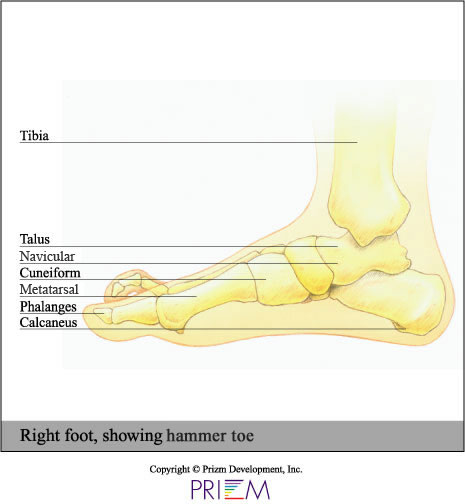Hammertoe
![]() A hammertoe is a deformity of the second, third or fourth toes. With this condition, the toe is bent at the middle joint, so that it resembles a hammer. Initially, hammertoes are flexible and can be corrected with simple measures but, if left untreated, they can become more rigid and require surgery.
A hammertoe is a deformity of the second, third or fourth toes. With this condition, the toe is bent at the middle joint, so that it resembles a hammer. Initially, hammertoes are flexible and can be corrected with simple measures but, if left untreated, they can become more rigid and require surgery.
Symptoms
Common symptoms of hammertoe include:
- Pain or irritation of the affected toe when wearing shoes.
- Corns and calluses (a buildup of skin) on the toe, between two toes, or on the ball of the foot.
- Inflammation, redness, or a burning sensation on the toe.
- Contracture of the toe.
- In more severe cases of hammertoe, open sores may form.
Causes
The most common cause of hammertoe is a muscle/tendon imbalance, which leads to a bending of the toe. This imbalance can result from mechanical (structural) changes in the foot that occur over time.
Hammertoes may be aggravated by shoes that don’t fit properly. A hammertoe may result if a toe is too long and is forced into a cramped position when a tight shoe is worn.
Occasionally, hammertoe is the result of an earlier trauma to the toe. With some patients, hammertoes are inherited.
Treatment Options
There is a variety of treatment options for hammertoe. The treatment your Lakelands Orthopedics foot and ankle surgeon selects will depend upon the severity of your hammertoe and other factors.
Non-surgical measures can include:
- Padding corns and calluses. Lakelands Orthopedics can provide or prescribe pads designed to shield corns from irritation. If you want to try over-the-counter pads, avoid the medicated types. Medicated pads are generally not recommended because they may contain a small amount of acid that can be harmful.
- Changes in shoewear. Avoid shoes with pointed toes, shoes that are too short, or shoes with high heels. These features can force your toe against the front of the shoe. Instead, choose comfortable shoes with a deep, roomy toe box and heels no higher than two inches.
- Orthotic devices. A custom orthotic device placed in your shoe may help control the muscle/tendon imbalance.
- Injection therapy. Corticosteroid injections are sometimes used to ease pain and inflammation caused by hammertoe.
- Medications. Oral nonsteroidal anti-inflammatory drugs (NSAIDs), such as ibuprofen, may be recommended to reduce pain and inflammation.
- Splinting/strapping. Splints or small straps may be applied by the surgeon to realign the bent toe.
In some cases, usually when the hammertoe has become more rigid and painful, or when an open sore has developed, surgery is required. In selecting the procedure or combination of procedures for your particular case, your specialist will take into consideration the extent of your deformity, the number of toes involved, your age, your activity level, and other factors. The length of the recovery period will vary, depending on the procedure or procedures performed.

 Foot & Ankle
Foot & Ankle